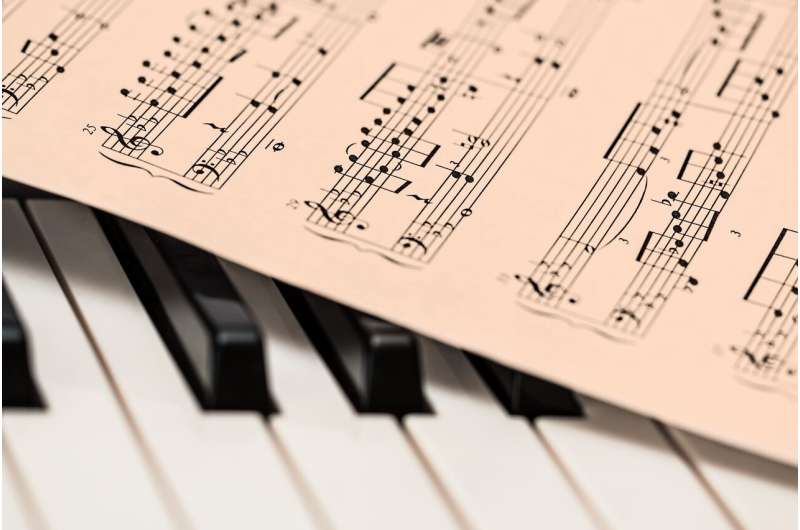The music therapy that helped Gabby Giffords speak again is getting dementia patients moving

Many of us know of music therapy as a way to soothe the troubled and stressed or to activate memories of favorite songs embedded deeply in the minds of people with dementia.
For her exercise classes in the nursing home at Paul's Run, a retirement community in Northeast Philadelphia, music therapist Molly Bybee taps the emotional power of music. But she also uses techniques from a newer and less-known approach called neurologic music therapy (NMT) to encourage more and better coordinated movement in participants who have memory problems and use wheelchairs.
Neurologic music therapy employs changes in rhythm, pitch and volume to cue movement. It was used to help former congresswoman Gabby Giffords speak again after she was shot at a community event in 2011. Joellyn Fox, lead physical therapist at the Dan Aaron Parkinson's Rehab Center at Pennsylvania Hospital, said her program doesn't have a music therapist, but all the other therapists are certified in a program called Music and Memory. They ask about favorite music on patient intake forms and use aspects of NMT to lift mood and help patients walk with a more relaxed and normal gait.
MedRhythms, a neurologic music therapy practice based in Boston, uses NMT for neurological diseases, including multiple sclerosis, and for brain injuries. When properly paired with actions, NMT can help the brain form new messaging pathways, founder Brian Harris said. MedRhythms is now testing a digital version of NMT to reach more patients at a time when trained therapists are in short supply.
Deforia Lane, who was director of art and music therapy at University Hospitals Cleveland Medical Center before retiring last year, has used it to relax patients before surgery—songs with 60 to 80 beats per minute are best for that—and to help stroke patients with aphasia learn to talk again. Neurologic music therapy has "really taken off" in recent years, she said.
Bybee uses NMT to emphasize her instructions to participants who may struggle with verbal commands alone. If she wants her students to raise their arms, she plays higher notes. Louder notes lead to bigger movements. Faster tempo means faster movements.
A 29-year-old with a strong singing voice, Bybee works with a challenging crowd. Fourteen people came for a recent Movers and Shakers class, all but one in a wheelchair. Most had dementia. Several were more than 100 years old, and Bybee guessed most were at least 90. Of four women asked their age, all said, convincingly, that they had forgotten. Several men were sleeping when Bybee arrived at 10 a.m. with her guitar.
Bybee, a University of Kansas grad who came to Paul's Run two and a half years ago, started by warming up their minds as well as their muscles. "You have to be the most exciting thing in the room," she explained later.
"Hello ladies. Hello gentlemen," she sang cheerily. "It's nice to see you again." She greeted each participant by name and asked how they were. "Fair. The day is young," one replied. Bybee asked them to "remind" her of the month and the day, a technique health professionals often use to orient patients who might be confused. She played catch with each class member, throwing a small ball back and forth five times. Then she made things harder by throwing the ball randomly so everyone had to pay attention. By 10:20 a.m., most of the class was awake and paying attention.
At that point, Bybee switched to NMT techniques. She handed out weighted maracas and jingle bells, instruments that encourage more movement. She began playing and singing songs derived from old pop songs she had rewritten to include simple exercise commands like "Shake it shake it" and "tap our toes, tap." The class moved their arms up, down and side to side and did the same with their feet. It was, of course, Bybee who worked the hardest. During the leg exercises, she showed the class what to do while standing on one leg, playing and singing.
She admitted it made her sweat a little. "I'm going to call the doctor for you," one class member quipped.
It would be harder to use pre-recorded music, she said, because she has to read the crowd and adjust the pace accordingly. Some days, they're really sluggish. On this one, they were alert, but she still had to slow down sometimes.
As the end of the 50-minute class was nearing, she finished as she usually does with her version of a 1950's song, "See ya later alligator. After a while crocodile." She gave each class member a chance to fill in some missing words, a task that was beyond some of them.
She praised them for their participation. "We worked really hard today," she said. "Sometimes you need to give yourself some self love. Think of all the wonderful things our bodies can do."
For a group like this the object is keep active enough to maintain some strength, not train for a 5K race. Bybee's goal is to keep people as engaged as possible. On this day, only one of the men slept through the whole class. Most looked livelier than they had before she arrived. Students praised the way she prepared for the class and individualized instruction. Two said they were happy to get some exercise and socialize.
They had no idea how Bybee had used simple melodies and rhythms to trigger improved movements. They just knew they felt better.
©2019 The Philadelphia Inquirer
Distributed by Tribune Content Agency, LLC.


















